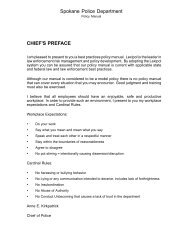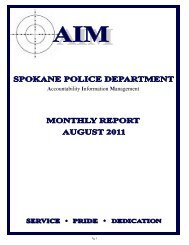DRAFT REPORT OF THE CITY OF SPOKANE USE ... - Samuel Walker
DRAFT REPORT OF THE CITY OF SPOKANE USE ... - Samuel Walker
DRAFT REPORT OF THE CITY OF SPOKANE USE ... - Samuel Walker
You also want an ePaper? Increase the reach of your titles
YUMPU automatically turns print PDFs into web optimized ePapers that Google loves.
Mr. Earl F. Martin<br />
RE: <strong>REPORT</strong> TO <strong>USE</strong> <strong>OF</strong> FORCE COMMISSION<br />
December 3, 2012<br />
Page 8<br />
program and the State's program would be prudent. Additionally, the Defensive Tactics Manual,<br />
Section V which deals with "Neck Restraints", indicates the technique is classified as deadly force.<br />
This is not the proper classification according to SPD policy as adopted on September 17, 2012 as<br />
set forth in section 300.2.5 or as articulated in the Special Policy Update from Lexipol. The<br />
designation of carotid or neck restraint techniques at the intermediate force level is more appropriate<br />
and is supported by CJTC. The Defensive Tactics Manual should be consistent with the SPD policy<br />
in this respect and with regard to the other force options as well. This is simply a matter of the<br />
Defensive Tactics Manual referring to the current use of force policy sections that are in place at all<br />
times. In practical terms this means that optimally, any time a new force policy is adopted by the<br />
SPD, the defensive tactics instructors should review and update the Defensive Tactics Manual. The<br />
updates should incorporate the revisions and specifically annotate with regard to the policy adoptions<br />
that are being incorporated and the date of the updates to the Defensive Tactics Manual.<br />
Additionally, the Defensive Tactics Manual needs to be revised to be clear that the use of pain<br />
compliance techniques on purely passive resistors is not in accordance with current case law and the<br />
recent policy updates from Lexipol.<br />
Of significant concern for the SPD defensive tactics program is the supporting information<br />
relating to legal concepts and federal civil rights throughout all of the documentation that was<br />
provided for my review. All of the materials appeared to be in need of revision to bring the materials<br />
up to date. For example, the force option scales used in the current version of the Defensive Tactics<br />
Manual need attention or should be completely eliminated. The resistance scale in the current manual<br />
for example breaks down the subject resistance into the following categories: compliant, passive<br />
resistant, active resistant, assaultive and life threatening. The officer response side of the scale lists<br />
the categories of force as: cooperative controls, contact controls, compliance techniques, defensive<br />
tactics and deadly force. This is problematic in that officers are legally permitted to use deadly force<br />
to prevent serious bodily injury (ie. great bodily injury) or death. Thus, the force options scale, if<br />
SPD chooses to use one, should be modified so that the current legal concepts with regard to<br />
non-deadly and non-deadly intermediate force (ie. pepperspray, ECD probe mode deployment and<br />
baton strikes) are accurately represented on any such scale as being only appropriate in the face of<br />
active resistance and where there is a threat of harm to officers or others.<br />
The relevant case law in this area has made it clear that force is either non-deadly or deadly;<br />
that within non-deadly force is a sub-category of force designated as intermediate force that includes<br />
pepper spray, ECD probe deployment and baton strikes. Police canines and neck restraints also fall<br />
within the non-deadly intermediate force level and, as stated above, intermediate force options<br />
require active resistance with a threat of injury to officer or others. The SPD Use of Force Scale does<br />
not depict these concepts accurately. It is also recommended that the phrase "less lethal" be removed<br />
from all materials as well as all policies, which is consistent with guidance from the policy provider<br />
Lexipol .
















